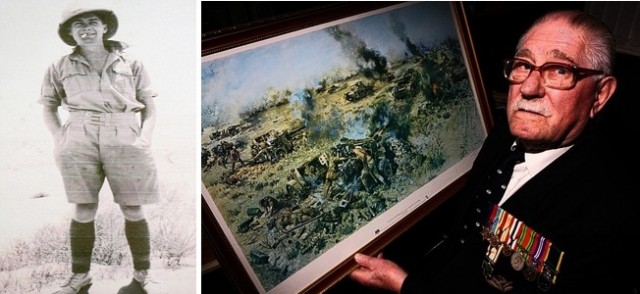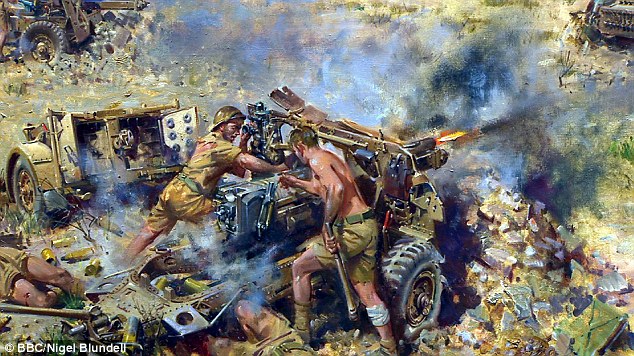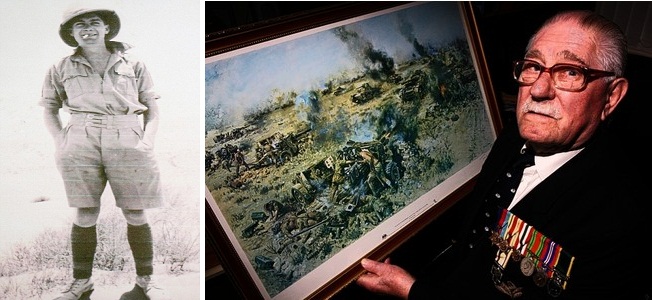
Ray Ellis – the brave and daring desert rat hero, the only surviving soldier of the 107th Regiment of South Nottinghamshire Hussars which fought one of the bloodiest battles of WWII, the 1942 ‘Battle of Knightsbridge’ and the last soldier to fire at incoming German troops – has died last February 18 at the Queen’s Medical Center in Nottingham.
WWII vet and hero Ray Ellis was 94 years old when he passed away.
“We regarded Ray Ellis and all those who fought as a band of brothers at Tobruk and Knightsbridge as heroes and the sacrifices that they made will never be forgotten.” said Colonel Tim Richmond, Honorary Colonel of the South Notts Hussars.
The Battle and Its Hero
The ‘Battle of Knightsbridge’ in 1942 is hailed as one of the most celebrated acts of bravery in the whole Royal Artillery history and one of the bloodiest battles to occur during the Second World War.
The said battle saw the demise of 107th Regiment of the South Nottinghamshire Hussars where the whole unit was wiped out save one and that was WWII veteran Ray Ellis.
Ray Ellis was even praised for being the last soldier from the said unit to fire out against the advancing German troops even up to the end of the battle sticking to the unit’s orders to “fight to last man to the last round”.
Throughout the 1942 ‘Battle of Knightsbridge’, the group of Desert Rats where Ray Ellis belonged suffered from the unrelenting Panzer attacks made by German Field Marshal Erwin ‘Desert Fox’ Rommel’s advancing tanks. Despite the the Desert Rats’ increasing casualties, Ray Ellis and his comrades held fast to the line in North Africa fighting the enemies to the end.
The heroism they displayed in one of WWII’s most gruesome battles was later immortalized on canvas in a Terence Cuneo war painting done in 1978.
Ray Ellis had given his own account on what really happened during the ‘Battle of Knightsbridge’:
“My regiment had been given the order to fight to the last man and the last round and not to retire, and this painting shows our position after a long day’s battle. I fought in that battle.
The regiment was almost wiped out – but by some miracle, I was the last man virtually, and I fired the last round. That round, which was at about six o’clock at night, hit a Mark IV tank.
Then the man standing at the side of me was killed because a German tank had come up behind us and fired its machine gun, almost point blank. And I took a deep breath and waited for mine.
For some reason the tank didn’t fire and I survived and am still here. You feel guilty for having survived. I found my comrade Jim Hardy lying nearby. He had been cut in two.
I took his water bottle and drank his water. I was in tears when I was taken prisoner.”

After Ray Ellis was captured, he was taken to a war camp as a POW. However, as he was shipped from Libya to a prison camp in Italy, he was able to set into motion a daring escape he had planned – walking out of the main gate as if on work party – and ran to the mountains where he hid for a year. While in hiding, a young girl found him and led him to a considerate farming family who gave him shelter.
After the war, Ray Ellis named one of his daughters Nerina after the little girl who led him to his safety and had made it a point to return to the hill village of Massa Fermana located near Ancona to visit the family who had took him in after he broke out of war prison.
Ray Ellis was among the 90 men from his regiment who were captured during the said battle so named, probably by a homesick soldier, as it was a barren desert crossing.
Ultimately, Ray Ellis wrote a book about his war experiences in the battle. His book bearing the title Once a Hussar was published last year.
“Ray Ellis was a true and proud South Notts Hussar. His exploits during the last war, from his joining the regiment in 1939, his survival at Knightsbridge, his imprisonment and ultimate escape from a PoW camp in Italy, so valuably recorded in his book Once a Hussar, have become a valuable archive as to what happened to a volunteer soldier,” stated Lieutenant Colonel David Young South Notts Hussars’ Association’s president whose uncle, Colonel Billy Seely, worked as a commanding officer in the Battle of Knightsbridge and was one of the soldiers who lost his life into that said campaign.
